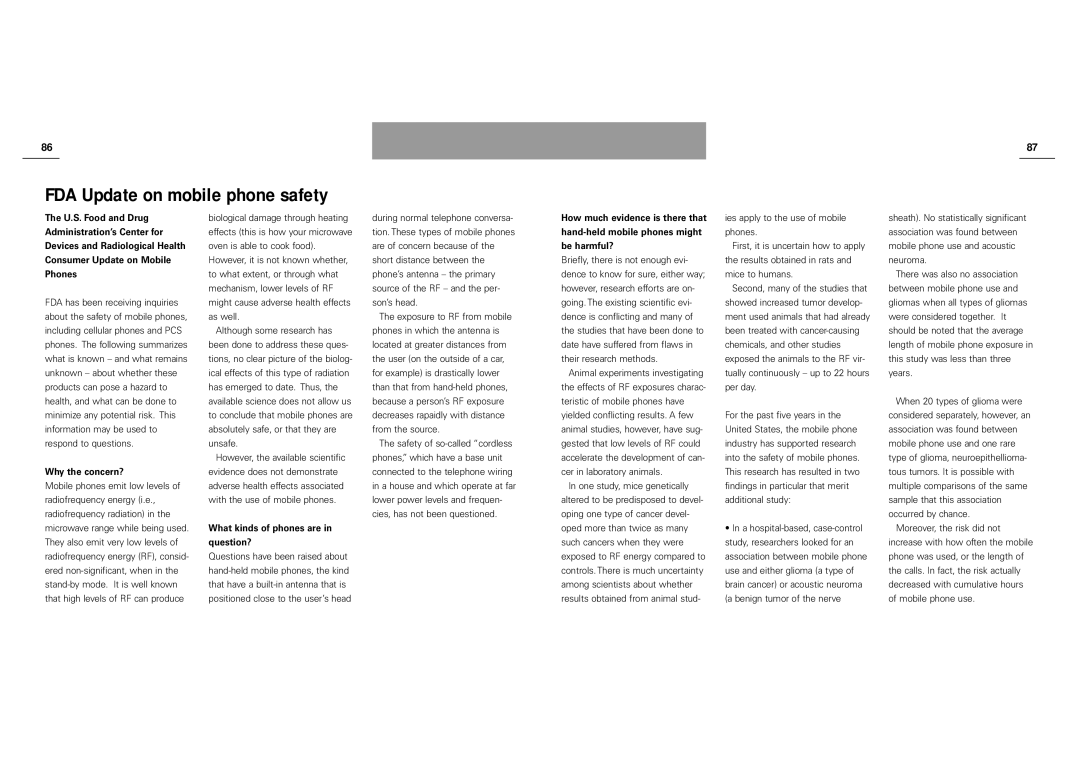
86
FDA Update on mobile phone safety
87
The U.S. Food and Drug
Administration’s Center for
Devices and Radiological Health
Consumer Update on Mobile
Phones
FDA has been receiving inquiries about the safety of mobile phones, including cellular phones and PCS phones. The following summarizes what is known – and what remains unknown – about whether these products can pose a hazard to health, and what can be done to minimize any potential risk. This information may be used to respond to questions.
Why the concern?
Mobile phones emit low levels of radiofrequency energy (i.e., radiofrequency radiation) in the microwave range while being used. They also emit very low levels of radiofrequency energy (RF), consid- ered
biological damage through heating effects (this is how your microwave oven is able to cook food).
However, it is not known whether, to what extent, or through what mechanism, lower levels of RF might cause adverse health effects as well.
Although some research has been done to address these ques- tions, no clear picture of the biolog- ical effects of this type of radiation has emerged to date. Thus, the available science does not allow us to conclude that mobile phones are absolutely safe, or that they are unsafe.
However, the available scientific evidence does not demonstrate adverse health effects associated with the use of mobile phones.
What kinds of phones are in
question?
Questions have been raised about
during normal telephone conversa- tion. These types of mobile phones are of concern because of the short distance between the phone’s antenna – the primary source of the RF – and the per- son’s head.
The exposure to RF from mobile phones in which the antenna is located at greater distances from the user (on the outside of a car, for example) is drastically lower than that from
The safety of
How much evidence is there that
be harmful?
Briefly, there is not enough evi- dence to know for sure, either way; however, research efforts are on- going. The existing scientific evi- dence is conflicting and many of the studies that have been done to date have suffered from flaws in their research methods.
Animal experiments investigating the effects of RF exposures charac- teristic of mobile phones have yielded conflicting results. A few animal studies, however, have sug- gested that low levels of RF could accelerate the development of can- cer in laboratory animals.
In one study, mice genetically altered to be predisposed to devel- oping one type of cancer devel- oped more than twice as many such cancers when they were exposed to RF energy compared to controls. There is much uncertainty among scientists about whether results obtained from animal stud-
ies apply to the use of mobile phones.
First, it is uncertain how to apply the results obtained in rats and mice to humans.
Second, many of the studies that showed increased tumor develop- ment used animals that had already been treated with
For the past five years in the United States, the mobile phone industry has supported research into the safety of mobile phones. This research has resulted in two findings in particular that merit additional study:
•In a
sheath). No statistically significant association was found between mobile phone use and acoustic neuroma.
There was also no association between mobile phone use and gliomas when all types of gliomas were considered together. It should be noted that the average length of mobile phone exposure in this study was less than three years.
When 20 types of glioma were considered separately, however, an association was found between mobile phone use and one rare type of glioma, neuroepithellioma- tous tumors. It is possible with multiple comparisons of the same sample that this association occurred by chance.
Moreover, the risk did not increase with how often the mobile phone was used, or the length of the calls. In fact, the risk actually decreased with cumulative hours of mobile phone use.
